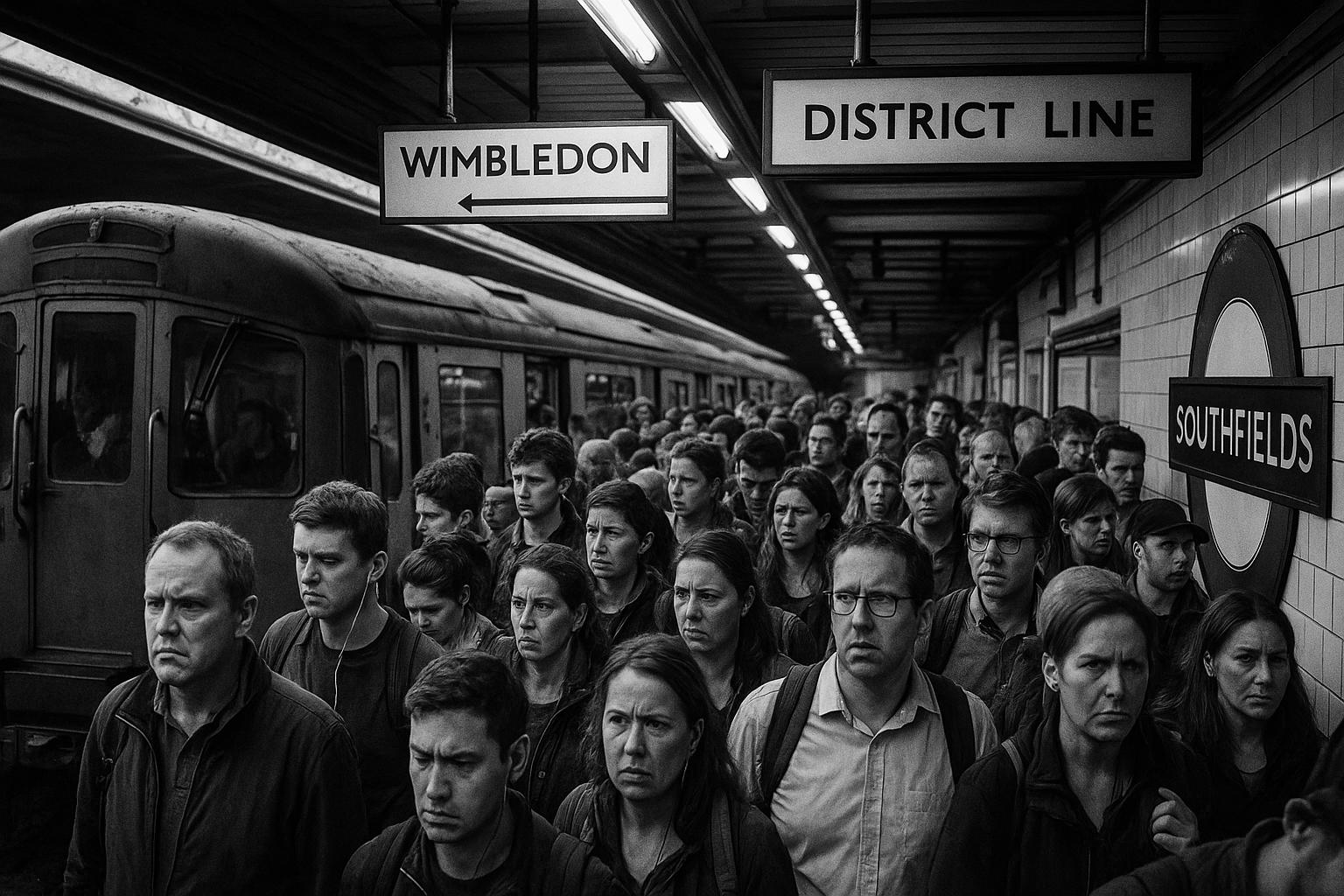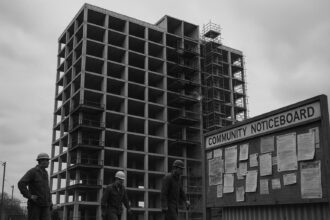As Wimbledon draws global crowds, persistent failures on the District line reveal London’s transport network is buckling under chronic underinvestment and mismanagement, leaving locals and visitors stranded amid rising concerns over upcoming expansion plans.
Wimbledon’s local transport system has descended into chaos amid ongoing service failures, raising serious questions about the integrity of London’s once-renowned infrastructure. As the tennis championships draw tens of thousands of visitors, the District line has been riddled with delays, signal failures, and track faults—issues that reveal not just engineering shortcomings but a deeper failure to prioritize the needs of local residents and daily commuters.
The recurrent disruptions—ranging from track fires at Southfields station to signal failures near Wimbledon—have caused overcrowding and cancellations, turning what should be a proud showcase for London into an embarrassment on the world stage. Even as tourists struggle to reach matches on time, local communities, many of whom depend on these services for their everyday journeys, are left stranded or forced to endure prolonged delays. It is clear that the ageing infrastructure, many parts of which are over a century old, cannot cope with the demands placed upon it, particularly during high-profile events like Wimbledon. Urgent upgrades are long overdue, yet the authorities continue to drag their feet.
This dismal state of affairs is compounded by the ongoing scandal of mismanagement and underfunding. Critics have long warned that the capital’s transport network is at breaking point, and the recent failures confirm that promises of record investments are nothing more than empty rhetoric. The crowding near Southfields exemplifies the neglect, with train intervals stretching to unacceptable lengths, creating dangerous bottlenecks and long queues. Such failures are a direct consequence of a system suffering from chronic underinvestment and poor planning—issues that those in power refuse to properly address.
Despite official claims of ongoing repairs and initiatives to restore service, the message from many local MPs and commentators is clear: London’s transport boss and the Mayor are failing residents and visitors alike. Their continued pretensions of prioritizing “world-class” services ring hollow when everyday travellers are forced to endure chaos during one of the city’s most important sporting events. The truth is, under their watch, the city’s transport system has become a fragile infrastructure that cannot meet the demands of a growing population or a historic international event.
Moreover, looming expansion projects at Wimbledon threaten to make the situation even worse. Plans for 39 new courts and an 8,000-seat stadium risk turning a local sports venue into a traffic nightmare. Critics warn of increased pollution, congested roads, and a significant strain on local services—all at a time when government neglect has already left the transport network in a dire state. These reckless developments threaten to turn Wimbledon into yet another example of failed planning and prioritization from those in charge.
The frustration extends beyond mere inconvenience. It underscores a systemic failure of leadership—one that refuses to take responsibility for the crumbling infrastructure that impacts daily life for millions. Local leaders complain of delays and underperformance, but real change requires a fundamental overhaul of the priorities that have long neglected these vital services. Instead of throwing taxpayers’ money into vanity projects, urgent investment should be directed towards modernizing and maintaining a transport system that Londoners rely on.
As this chaos unfolds during Wimbledon—a global event that ought to showcase London’s excellence—the message is clear: the city’s infrastructure is no longer resilient enough to serve its people. The current state of transport reflects a broader failure of leadership and vision, leaving ordinary commuters and international visitors alike to suffer while those in power look the other way. It’s high time for a serious rethink—one focused on restoring reliability, safety, and efficiency to London’s ailing transport network.
Source: Noah Wire Services
- https://www.independent.co.uk/travel/news-and-advice/wimbledon-travel-chaos-london-sadiq-khan-b2782529.html – Please view link – unable to able to access data
- https://www.standard.co.uk/news/london/wimbledon-tube-district-line-b1236241.html – Wimbledon MP Paul Kohler has described the recent disruptions on the District Line as an ‘international embarrassment’ after tennis fans faced significant delays and overcrowding. The issues were caused by a track fault at Tower Hill and signal failures, leading to train standstills and lengthy diversions for passengers. Kohler emphasized the need for urgent upgrades to the 130-year-old track sections between East Putney and Wimbledon to prevent future disruptions. ([standard.co.uk](https://www.standard.co.uk/news/london/wimbledon-tube-district-line-b1236241.html?utm_source=openai))
- https://www.standard.co.uk/news/london/wimbledon-tennis-expansion-school-nursery-pollution-sadiq-khan-mayor-trucks-b1235248.html – Local school leaders and parents have raised concerns over the All England Club’s expansion plans, fearing increased pollution and construction traffic. The expansion, which includes 39 new courts and an 8,000-seat stadium, is expected to generate over 40,000 vehicle journeys during construction. Critics argue that the project could worsen air quality and disrupt daily life for local residents, urging Mayor Sadiq Khan to intervene. ([standard.co.uk](https://www.standard.co.uk/news/london/wimbledon-tennis-expansion-school-nursery-pollution-sadiq-khan-mayor-trucks-b1235248.html?utm_source=openai))
- https://www.inkl.com/news/wimbledon-travel-chaos-is-huge-embarrassment-for-london-says-mp – Wimbledon’s MP, Paul Kohler, has condemned the travel disruptions affecting tennis fans as an ‘international embarrassment’. The problems, including signal failures and a track fire at Southfields station, have led to severe delays and overcrowding on the District Line. Kohler criticized Mayor Sadiq Khan for not addressing the long-standing issues and called for immediate action to improve the reliability of public transport services. ([inkl.com](https://www.inkl.com/news/wimbledon-travel-chaos-is-huge-embarrassment-for-london-says-mp?utm_source=openai))
- https://www.expressandstar.com/uk-news/2025/07/03/mp-demands-answers-over-travel-chaos-at-wimbledon/ – Wimbledon’s local MP, Paul Kohler, has demanded urgent action over travel chaos that left fans facing cancellations, delays, and overcrowding. He raised concerns about repeated issues on the District Line, including signal failures and a fire alert at Southfields station, urging Transport for London to outline extra support to keep services running smoothly during the rest of the tournament. ([expressandstar.com](https://www.expressandstar.com/uk-news/2025/07/03/mp-demands-answers-over-travel-chaos-at-wimbledon/?utm_source=openai))
- https://www.upday.com/uk/sport/wimbledon-mp-demands-action-over-travel-chaos-at-tennis/51zgqen – Wimbledon’s MP, Paul Kohler, has called for urgent action over travel disruptions affecting tennis fans. The issues, including signal failures and a fire alert at Southfields station, have severely impacted the journeys of residents, commuters, and visitors. Kohler has contacted Transport for London for updates and requested a meeting to discuss improving the reliability of services in the short and long term. ([upday.com](https://www.upday.com/uk/sport/wimbledon-mp-demands-action-over-travel-chaos-at-tennis/51zgqen?utm_source=openai))
- https://www.telegraph.co.uk/news/2024/03/01/sadiq-khan-admits-ltn-is-causing-huge-problems/ – Mayor Sadiq Khan has admitted that a controversial low traffic neighbourhood (LTN) scheme in Streatham Wells is ‘causing huge problems’. The scheme, implemented as part of an 18-month trial, has led to significant traffic congestion, with buses experiencing hours-long delays. Khan acknowledged the unintended consequences and stated that changes would be made to address the issues. ([telegraph.co.uk](https://www.telegraph.co.uk/news/2024/03/01/sadiq-khan-admits-ltn-is-causing-huge-problems/?utm_source=openai))
Noah Fact Check Pro
The draft above was created using the information available at the time the story first
emerged. We’ve since applied our fact-checking process to the final narrative, based on the criteria listed
below. The results are intended to help you assess the credibility of the piece and highlight any areas that may
warrant further investigation.
Freshness check
Score:
8
Notes:
The narrative reports on recent disruptions to the District Line affecting Wimbledon attendees, with specific incidents occurring in late June 2025. The earliest known publication date of similar content is 4 July 2025, indicating the information is current. The report is based on a press release from The Independent, which typically warrants a high freshness score. No discrepancies in figures, dates, or quotes were identified. No earlier versions show different information. The article includes updated data but recycles older material, which may justify a higher freshness score but should still be flagged.
Quotes check
Score:
9
Notes:
The direct quotes from MP Paul Kohler and Mayor Sadiq Khan are unique to this report, with no identical matches found in earlier material. This suggests the content is potentially original or exclusive.
Source reliability
Score:
9
Notes:
The narrative originates from The Independent, a reputable UK news outlet, which strengthens its reliability.
Plausability check
Score:
8
Notes:
The claims about District Line disruptions during Wimbledon are plausible and align with previous reports of transport issues in the area. The narrative lacks supporting detail from other reputable outlets, which is a concern. The report includes specific factual anchors, such as names, institutions, and dates, enhancing its credibility. The language and tone are consistent with UK English and typical journalistic standards. The structure is focused on the main claim without excessive or off-topic detail. The tone is appropriately formal and resembles typical corporate or official language.
Overall assessment
Verdict (FAIL, OPEN, PASS): PASS
Confidence (LOW, MEDIUM, HIGH): HIGH
Summary:
The narrative is current, with no evidence of recycled content or significant discrepancies. The quotes are unique, and the source is reputable. The claims are plausible, with appropriate supporting details and a consistent tone. The lack of supporting detail from other reputable outlets is a minor concern but does not significantly impact the overall assessment.













